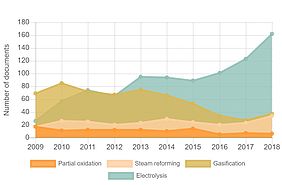Hydrogen is counted among the cleanest and most sustainable energy sources as it does not release harmful emissions into the atmosphere and can be employed in many industry sectors, including transportation and power generation. Effective technologies for transporting and storing hydrogen are paramount to a well-functioning hydrogen economy, but contemporary means to do so are expensive and susceptible to contamination. Therefore, researchers are continuously looking for reliable, simple and low-cost means to store and transport hydrogen, which will eventually benefit many applications, such as power supply and green vehicles.
Now (2021), scientists at Berkeley Laboratory have created an effective material for speeding up one of the most problematic stages in hydrogen extraction from alcohols. The material, a catalyst, is made from tiny clusters of nickel metal embedded in a 2D substrate. The scientists were able to enhance the performance and stability of these metal-based catalysts by adapting a strategy that focused on tiny, uniform clusters of nickel metal. Tiny clusters, they found, were important because they maximized the exposure of reactive surface. However, they also showed a tendency to clump together, which inhibited their reactivity.Therefore, an experiment was conducted which tried to reduce clumping by depositing 1.5-nanometer-diameter nickel clusters onto a 2D substrate made of boron and nitrogen engineered to form a grid of atomic-scale dimples. The nickel clusters were evenly distributed and securely fixed in the dimples. Not only did this design avert clumping, but its thermal and chemical properties greatly increased the performance of the catalyst through direct interaction with the catalyst with the nickel clusters.
Employing detailed X-ray and spectroscopy measurements, combined with theoretical calculations, the researchers were able to observe changes in the physical and chemical properties of the 2D sheets while tiny nickel clusters were occupying pristine regions of the sheets and interacting with nearby edges.This preserved the tiny size of the clusters. The tiny, stable clusters were responsible for the action in the processes through which hydrogen was separated from its liquid carrier and equipped the catalyst with excellent selectivity, productivity, and stable performance.
Improving hydrogen extraction has been at the centre of scientific attention for quite some time. In 2019, scientists used methanol as a hydrogen carrier to extract hydrogen in situ with a single-site Pt1/CeO2 catalyst. In this reaction, compared with traditional nanoparticle catalysts, the single site catalyst showed excellent hydrogen generation efficiency, 40 times higher than the 2.5 nm Pt/CeO2 sample, and 800 times higher compared to 7.0 nm Pt/CeO2 sample. This in-depth study demonstrated the benefits of single-site catalysts and paved the way for further development of highly efficient catalysts for sustainable energy storage applications.
In 2020, scientists created ultra-small nickel nanoclusters (∼1.5 nm) deposited on defect-rich BN nanosheet (Ni/BN) catalysts with high methanol dehydrogenation activity and selectivity. For this purpose, nanoclusters (∼1.5 nm) deposited on defect-rich boron nitride (BN) nanosheet (Ni/BN) catalysts with higher methanol dehydrogenation activity and selectivity, as well as greater stability than that of some other transition-metal based catalysts were created. The interface of the two-dimensional (2D) BN with the metal nanoparticles was important both for controlling the nucleation and growth of the catalytically active ultra-small Ni nanoclusters, and further for stabilising these nanoscale Ni catalysts against poisoning by interactions with the BN substrate. They performed detailed spectroscopy characterizations and density functional theory (DFT) calculations to analyse the reason for the high productivity, high selectivity, and high durability exhibited with the Ni/BN nanocatalyst and determine its correlation with nanocluster size and support–nanocluster interactions. They found that an idiosyncratic metal–support interaction was not only important for enhancing the one-pot synthesis of ultra-small Ni nanoclusters with high catalytic activity, but also strongly enhanced the resistance to sintering and coking during methanol dehydrogenation.
The new catalyst design has several advantages over commercially-employed ones: first and foremost, the size of the catalyst was the reason its activity was among the best, because bare metal atoms more readily attracted the liquid carrier than did larger metal particles. These exposed atoms also helped to improve the steps of the chemical reaction that extracts hydrogen from the carrier, while preventing the formation of contaminants that may clog the surface of the cluster. Thus, the material did not get contaminated during key steps in the hydrogen production reaction. These catalytic and anti-contamination properties were caused by the imperfections that had been deliberately created in the 2D sheets and helped keep the cluster size small. Experiments showed that the catalyst could cleanly and efficiently speed up the reaction that removes hydrogen atoms from a liquid chemical carrier. The material is robust and made from earth-abundant metals rather than from precious metals and will help make hydrogen a viable energy source for a wide range of applications.
This catalyst provides evidence that inexpensive and readily-available material can form a highly effective catalyst to separate hydrogen from liquid carriers for use as a fuel. This research might be a further step towards the goal of safe hydrogen storage and materials optimization for use in vehicles and power generation.
